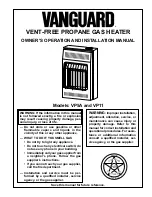
2
Installation
8
Hot Water Generator Installation and Operation Manual
Connecting the energy source
(Steam or boiler water)
WARNING
Steam or boiler water present situations
that can be very dangerous because of the
high temperatures and pressures.
Use
common sense and follow all accepted and
recommended procedures when
performing installation, operation, and
maintenance procedures to avoid possible
injury or death.
Assure that a manual shutoff valve is installed upstream in the
steam or boiler water line (energy source), and that it is
functioning properly.
If any doubt exists concerning the
integrity of the shutoff valve, replace the valve before
attempting installation. All energy source valves should be
closed and remain closed throughout the installation process.
Connect the energy source to the line(s) leading to the
temperature control valve.
The exact location of the
temperature control valve for the specific unit, as well as
energy source pipe diameter and thread size, can be
determined from the CAD drawing(s) supplied with the unit.
NOTICE
For all energy source piping connections,
the use and / or type of joint compound or
sealer on the joint should be determined by
referring to local codes, accepted practices,
or the requirements of the installing
contractor.
Connecting the steam condensate
line or the boiler water return lines
Steam condensate return line
As the heat is extracted from the steam and transferred to the
water heating system, condensate will form. This condensate
must have a means by which it can drain from the unit and
return to the steam system. The condensate return line serves
this purpose.
The condensate return line should be connected to the unit at
the condensate return port. The condensate port is normally
located downstream from the main and auxiliary traps. The
exact location of this port for the specific unit, as well as the
condensate return pipe diameter and thread size, can be
determined from the CAD drawing(s) supplied with the unit.
The condensate line should be piped back into the site’s steam
system for recycling.
A manual shutoff valve should be installed downstream in the
condensate return line to allow the unit to be isolated from the
system. The condensate shutoff valve will prevent backflow of
steam if the line is disconnected.
WARNING
Do not attempt to lift condensate with a
float and thermostatic trap.
Pipe the
condensate outlet from the main steam
trap to a gravity drain or to a condensate
pump.
Lifting condensate without the assistance
of a condensate pump can cause erratic
temperature control, failure of the tube
bundle, damage to the control valve, or
damage to the condensate trap. Any failure
caused due to lifting of condensate without
a condensate pump is not covered by the
warranty.
Boiler water and high temperature water
return line
After the boiler water has passed through the tube bundle, and
the heat has been extracted and transferred to the domestic
water system, the water must return to the system. The water
return line serves this purpose.
The water return line should be connected to the unit at the
return port. Unlike the steam condensate return line, the
return lines for boiler water do not have in-line condensate
traps. The exact location of this port for the specific unit, as
well as the water return pipe diameter and thread size, can be
determined from the CAD drawing supplied with the unit.
A manual shutoff valve should be installed downstream in the
water return line to allow the unit to be isolated from the
system. The water return shutoff valve will present backflow
of boiler water if the line is disconnected.
Piping the relief valves to drain
All Lochinvar Hot Water Generators are equipped with a
pressure relief valve for the tank. The valve should be piped to
a vent line leading to a suitable drain. Piping the pressure
relief valves to suitable drains will prevent both water and heat
damage to the unit, as well as reduce the risk of injury from
released steam or water. The pipe must be of adequate size to
properly handle the capacity of the relief valve and vent line.
Check local codes to assure compliance.
If a check valve has been installed on the inlet water line,
thermal expansion may take place causing build up of
excessive pressure when the water is being heated.
This
expansion will cause the relief valve to open, releasing hot
water to the vent line.









































